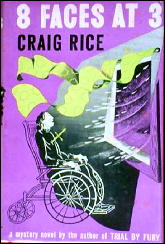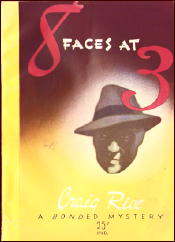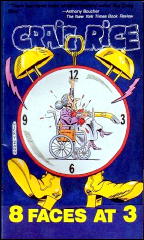Mon 8 Feb 2010
CRAIG RICE – 8 Faces at 3. Simon & Schuster, hardcover, 1939. Hardcover reprint: Tower, 1943 (shown). Paperback reprints include: Mystery Novel of the Month #21, 1941, as Murder Stops the Clock; Bonded Books #13, 1945; Intl Polygonics Ltd, 1989.

Rice’s debut detective novel, which introduced that rye-soaked couple, Jake Justus and Helene Brand, and the rumpled, sodden lawyer John J. Malone to the world, is an impressive debut.
The first murder — that of a tyrannical, rich old lady despised by her heirs and servants — offers a classical situation immediately familiar to readers of British mystery, but the resemblance begins careening off course with the appearance of madcap, hard-drinking, reckless-driving heiress Helene Brand on the scene.
Soon the lovely young lady suspect — a family friend of Helene’s and the newlywed wife of a band leader client of Jake’s (he’s a press agent) — has been spirited away from the police by Jake and Helene and hidden away in a whorehouse, so that Jake and Helene can find the real murderer, with the help of Malone.
Copious drinking ensues, along with some genuine detection.
Despite all the drinking (which is truly non-stop), Rice’s first detective novel devotes considerable attention to the puzzle, which, though not as convoluted as some of her later ones, is nicely put together.

Rice wastes little time on red herrings, but the exact working out of everything, including the tantalizing problem of the eight clocks all set to 3:00, is interesting to follow. (Rice works out the Clock conundrum in much more interesting way than does Agatha Christie in the later The Clocks.) Indeed, as a puzzle 8 Faces at 3 is superior to Rice’s later Trial by Fury (considered her masterpiece by some), though the latter is the better novel.
The supporting characters in 8 Faces at 3 tend to remain cardboard (the most interesting to me was the presumably Jewish D.A. with a chip on his shoulder, Hyme Mendel), so the interest tends to remain in puzzle and the antics of Helene, Jake and Malone.
The antics, fueled by rye and many other adult beverages, will be a plus or minus depending on the reader. Much of the book I found genuinely funny, but I have to admit the amount of drinking did tend to pall on me a bit. One starts to feel that almost every other line, is “let’s have a drink.”

I have not yet received Jeffrey Mark’s biography of Craig Rice, but I know a bit of her sad story and I have to admit I found myself thinking of that every time Helene passed out into Jake’s arms.
I presume readers of the 1940s found drunkenness more uproariously funny than readers of today; and of course those readers of yesteryear did not know of Rice’s own alcoholism — at least until her messy personal life, including suicide threats, started, I presume, to get in the papers.
For me that knowledge tempered a bit my amusement at the non-stop drinking, which is frequently accompanied, I might add, by driving. (These characters make Raymond Chandler’s Marlowe look like a teetotaler.)
Still, 8 Faces at 3 offers an a good puzzle and is written with verve. It is a very good detective novel and I would recommend it to anyone who doesn’t mind a great deal of liquor-fueled zaniness accompanying the elucidation of a mystery.
Editorial Comment: Also on hand is Curt’s review of Trial by Fury, which he mentioned in passing above. Be on the lookout for it. I’ll post it here soon.
February 9th, 2010 at 10:25 pm
I remember when a movie, a comedy, called ARTHUR came out and was all the rage. Starred Dudley Moore, and he was nominated for an Oscar for his performance as a drunken playboy looking for love or some such.
Emphasis on the word “drunken.” I found it not funny at all.
That was in 1981. Am I wrong in thinking that since then Hollywood has gotten away from the idea that drunks are funny?
Maybe I’m just imagining it. Hollywood, as I understand it, still thinks a lot of things are funny that I don’t, and you’re welcome. I won’t mention them here!
February 10th, 2010 at 12:17 am
How about the famous vitaveetavegemin skit done by Lucille Ball on I love Lucy, when she gets progressively drunker with each take of the ad, cause the energy drink she has to taste each take is mostly alcohol? Watch Lucy get drunk, ha ha! And that was America’s premier family shows (and then there’s the smoking). It does seem to me like cultural attitudes have changed a great deal.
But I did enjoy the book. And I’m about to start Jonathan Latimer, who I gather can give anyone a run for their her when it comes to fictional drunkenness.
February 10th, 2010 at 6:37 am
I think loss of control is always a part of slapstick and alcohol renders the person typically unable to understand that lack of control, so they continue to behave as if there was still some control (e.g. Lucy thinking she can still pronounce the words in the ad.)
I haven’t read Latimer in years, but yes, I remember him making my liver hurt 🙂
February 10th, 2010 at 11:28 am
I LOVE LUCY was sponsered by a cigarette company which explains the smoking. As for drunkeness, I forget his name but there was a comic drunk on Dean Martin’s show who was almost a regular.
February 10th, 2010 at 12:29 pm
Foster Brooks. His shtick was to be just drunk enough that his words and sentences didn’t come out right, pretty much the same way Jeff describes Lucy on her show.
One difference “Arthur” and Brooks, though, is that Lucy as a character was blissfully unaware she’d been drinking.
As for Jonathan Latimer, if there’s another author that could challenge Craig Rice in the amount of non-stop imbibing that their characters do, he’s the guy.
Curt, using Latimer as a chaser to Rice is playing a dangerous game. Make sure you take your designated driver along with you!
February 10th, 2010 at 9:15 pm
Nick Charles in Hammett’s “The Thin Man” doesn’t drink quite as much as William Powell does in the role, but really, even in the novel, Nick Charles should have been as nearly as looped as Arthur Bach.
Still: other times, other mores.
Drunks in period movies and period novels I have no trouble accepting in the spirit(s) originally intended…
February 10th, 2010 at 10:18 pm
I think that’s a good point about using alcohol as a way of allowing your characters to act wacky. In a more buttoned-down age, I imagine alcohol served as more of an inhibition-reducer (still does today to some extent). But by any reasonable definition, the three regulars in the main Rice series would have to be seen as alcoholics–every occasion calls for a drink! And the thing is, Helene at least would be quite believable to me acting the way she does even without alcohol. She seems very much the willful screwball heiress type, a la Katherine Hepburn in Bringing Up Baby or Barbara Stanwyck in The Mad Miss Manton.
It occurs to me that some certainly big name American mystery writers were alcoholics: Hammett, Chandler, Rice, Carr, for example. Drinking and/or drunken-type behavior seems pretty common in their books (even when Carr’s characters aren’t drinking they often have this emphatic way of speaking and acting which makes them sound drunk to me, like when a drunk suddenly decides to get eloquent on you at great length about this Really Important Point).
February 11th, 2010 at 7:18 pm
As far as I can tell the champion drinker in mystery fiction is Peter Cheyney’s Slim Callaghan, whose consumption could pickle a herring. He easily puts Malone and company and even Latimer’s Bill Crane under the table. Sometimes you fear for Slim to light a cigarette though he is never drunk, worse for wear, or out of action despite heroic consumption.
Drinking to excess was in part a throwback to the roaring twenties and prohibition. Drunks had always been a source of humor (Shakespeare’s Falstaff), but the twenties added an aura of sophistication and youth to the consumption of booze. Bulldog Drummond was a big beer and martini consumer as were the heroes and heroines of P.G. Wodehouse’s books and stories.
And it’s no more politically incorrect than the way we laughed at Cheech and Chong or the jokes done today about Amy Whitehouse on the Late Night circuit.
And anyway, bad as the drinking by Rice’s character’s is it is still probably healthier than Holmes cocaine (which Doyle had used) or whatever the hell M.P. Shiel’s Price Zaleski was smoking,
But booze and the hard boiled genre go together like olives and martini’s. Gin soaked is probably the first thing to come to mind when you think of them, especially the screwball school of Rice, Latimer, and others. You can’t separated them anymore than you can Marlowe from his bourbon, Bond from his vodka martini, Nero Wolfe from his beer, or Maigret from his Calvados and Pernod.
And to be fair, if we were going to apply the rules of the real world to Rice’s fiction Malone would have been disbarred before the first book made print along with Perry Mason. You really can’t blame writers from the past if they didn’t anticipate how we would feel about what they thought was funny in another time and place.
February 11th, 2010 at 9:07 pm
No, I’m not blaming Rice, just explaining my own personal reaction. I did enjoy the book and Trial by Fury even more so. Didn’t like a couple others as much, but I plan to read the rest.
Inevitably people are going to have reactions against “politically incorrect” elements in books. However, what sets one person off may not another. Some people enjoy Spillane, I can’t stand him. I like Stout, but was disappointed to see Archie announce in one novel that when he looks at a woman over forty he normally wants immediately to look somewhere else and that he wouldn’t consider dating a woman over thirty. How old is Archie supposed to be, anyway? I always assumed HE was in his thirties. I know it’s a convention of the times, but this is the kind of thing that gives me sympathy with Betty Friedan! Yet it’s not so egregious that I can’t overlook it in an author I otherwise enjoy, as I do Stout.
In the book Thrillers, the author took time out to castigate Chandler at length for extreme racism in Farewell, My Lovely; but I have to admit I never saw his treatment of African Americans in that book as racist. On the other hand, his treatment of homosexuals and women in The Big Sleep rather repulsed me (it doesn’t help that I found the plot to be a huge mess). So these reactions will vary from person to person–to each his own perception.
I tend to think that English mystery novels get more criticism for anti-Semitism and classism than American novels get criticized for anything, but maybe I’m incorrect. American mystery novels definitely have their non-PC aspects, however!
February 11th, 2010 at 9:45 pm
[…] 8 Faces at 3 (by Curt Evans) Trial By Fury (by David Vineyard) People vs. Withers & Malone by Craig Rice & Stuart Palmer (by Bill Pronzini and George Kelley) […]
February 12th, 2010 at 8:12 am
Curt
I certainly agree, and you can never predict what will bother you. I suppose I might find Spillane more offensive if I took him seriously, but reading him just for fun much that might otherwise bother me just goes by.
Cleve Adams is often criticized for the line “What this country needs is an American Gestapo” in one of his books, but taken in context the line is delivered by his private eye hero Rex McBride, who Adams makes clear to us is a man of his class and role in society. In all fairness it is the sort of thing someone like Rex McBride would actually say rather than the author’s opinion.
Mordechai Richter, the Canadian writer took John Buchan to task for the line “a Jew with an eye like a rattlesnake” in THE THIRTY NINE STEPS, and yet when you read the actual novel the line is said by a paranoid American character who turns out to be wrong about the nature of the conspiracy (the “Jew” isn’t even involved), and a less than attractive character.
The drinking in Rice’s novels and others of that era is something like that. It reflects the writer and the world she is writing about, and while I might recognize the damage done by drinking in the real world I can’t really see the harm here. I’m a huge fan of Rice, Ian Fleming, Chandler, and Nero Wolfe, and barely qualify as a drinker. If you are led astray by fiction you probably were going that way on your own.
I agree Archie’s line is stupid, but since Stout was forty when he started the series the line may well be there in order to make us prick up our ears. Stout isn’t beyond poking the reader with a stick to see if he is paying attention.
I have to agree about FAREWELL MY LOVELY, where the racism feels more like observation than rancor, but the homophobia and anti femme material is sharper and more felt by the writer, and thus the modern reader.
Still I don’t demand much of writers as people. If you did you couldn’t read much of anything. Hemingway was a bully, Fitzgerald and Faulker drunks, Hammett an unrepentant Stalin apologist, Sayers an anti-Semite, and Lewis Carroll a borderline pederast (and not all that borderline).
If I limit myself to only nice writers I’d end up reading nothing but Beatrix Potter — and even she had her moments.
Sadly talent exists in flawed human beings who have feet of clay like the rest of us. Sometimes we have to judge them on their best qualities rather than lingering over their flaws.
But that said we are human too, and what bothers us bothers us. The trick is to admit our prejudices too and how they effect our judgments, and as Curt does here state clearly what bothered him and didn’t and why and let the reader of the review decide for himself whether to read the book in question or not. That is all any honest reviewer can hope to do.
August 29th, 2020 at 3:25 pm
[…] Prior Rulings – Les Blatt @ Classic Mysteries, Curtis Evans’ review @ Mystery*File […]
August 5th, 2022 at 2:58 pm
[…] Prior Rulings – Les Blatt @ Classic Mysteries, Curtis Evans’ review @ Mystery*File […]